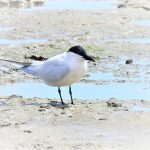AUSTRALIAN TERN
The Australian Tern is a fascinating and somewhat elusive bird that graces the Australian skies and shorelines. This bird, also referred to as the Gull-billed Tern, has a story woven from the coastlines to the inland waterways of Australia, showcasing a remarkable journey through the seasons.
It is found across various habitats in Australia, including coastal regions, estuaries, and even inland water bodies. Its presence spans from the tropical north down to the more temperate southern regions, adapting seamlessly to each unique environment. During the breeding season, these birds are more commonly found in northern Australia, but their nomadic nature means they can appear almost anywhere across the continent, following the ebb and flow of water bodies that sustain them.
The breeding season of the Australian Tern is a testament to its adaptability, typically occurring during the warmer months, from September to December. They are not your average nesters; instead of trees, they prefer to lay their eggs on the ground, choosing sites on sandy beaches, islands, or even salt pans. The nests are simple scrapes in the ground, often lined with vegetation or small objects found nearby. This simplicity, however, does not detract from the care they invest in raising their young. Both parents share the responsibility of incubating the eggs and feeding the hatchlings, showcasing a remarkable commitment to their offspring’s survival.
The Australian Tern, with its sleek white body, sharp wings, and distinctive black cap, can live up to an impressive 10-15 years in the wild, a testament to its resilience.
Vocalisations of these birds are particularly intriguing; their calls are a mixture of sharp, barking sounds and more melodious notes, which they use to communicate with each other, especially during the breeding season. These sounds add a unique auditory layer to the landscapes they inhabit, from the bustling estuaries to the serene coastlines.
One of the most captivating aspects of the Australian Tern is its diet, which is quite varied compared to other tern species. They feed on a wide range of prey, including fish, insects, and even small amphibians, showcasing their adaptability not just in habitat but also in sustenance.
While the Australian Tern is currently not considered endangered, its story is a poignant reminder of the importance of preserving natural habitats and waterways. Their nomadic lifestyle and wide-ranging habitats highlight the interconnectedness of ecosystems across Australia. By protecting these environments, we not only safeguard the future of the Australian Tern but also the myriad of other species that share their home.










